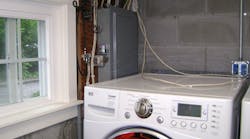How well do you know the Code? Think you can spot violations the original installer either ignored or couldn't identify? Here's your chance to moonlight as an electrical inspector and second-guess someone else's work from the safety of your living room or office. Brian, who has a knack for finding shoddy electrical work, did the dirty work and found this mess. Now it's your turn to identify the violation.
Find the Answer
This photo shows a situation that is often found in residential occupancies, after the electrical contractor has left the job. This homeowner located a washer/dryer directly in front of the service equipment, which is a violation of the working space requirements of 110.26, "Space About Electrical Equipment."
The first portion of 110.26 states, "Sufficient access and working space shall be provided and maintained about all electrical equipment to permit ready and safe operation and maintenance of such equipment." The dimensions of the work space are defined by the criteria presented in parts (A)(1), (A)(2), and (A)(3).
(A)(1) stipulates the "depth" of the work space. It says, "The depth of the working space shall not be less than that specified in Table 110.26(A)(1), unless the requirements of 110.26(A)(1)(a), (A)(1)(b), or (A)(1)(c) are met." Because those portions of this rule do not apply in this situation, the "depth" of the working space that must be provided and maintained is 3 ft [as noted in Table 110.26(A)(1)]. That dimension must be "measured from the exposed live parts of the front of the enclosure or opening, if the live parts are enclosed." Adequate side-to-side clearance, or "width," as described in part (A)(2), is 30 in. or the width of the equipment, whichever is greater. The "height" clearance must be 6.5 ft or the height of the equipment, whichever is greater.
It should be noted that even though the wording of this rule requires the working space must be maintained, for all practical purposes, this is an impossible situation for the installer to accomplish, unless the installer is also the maintenance electrician on the premises. If not, there is no way to prevent a homeowner from doing what we see in this photo. Because the property owner is the party responsible for "maintaining" the work space, the electrical installer should not be held responsible.
One other concern we can point out is the requirements noted in 240.24(A). This rule says, "Overcurrent devices shall be readily accessible…", which is defined in Art. 100 as, "capable of being reached quickly for operation, renewal, or inspections without requiring those to whom ready access is requisite to climb over or remove obstacles or to resort to portable ladders, and so forth." In this situation, if anyone needed to open the panelboard door, they would first have to move the washer/dryer, which is an obvious violation of the this definition and the wording of 240.24(A).



